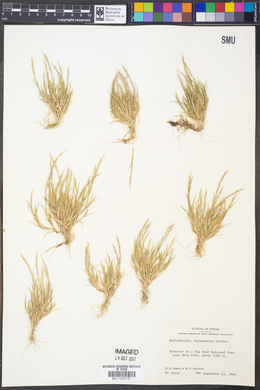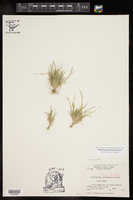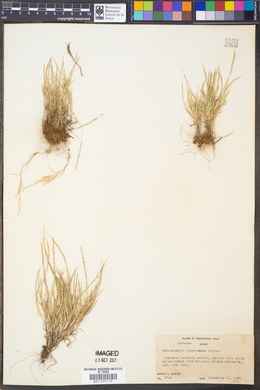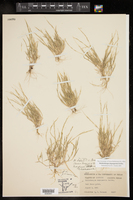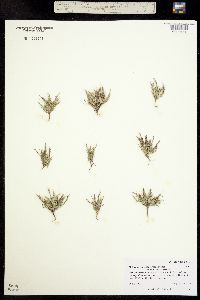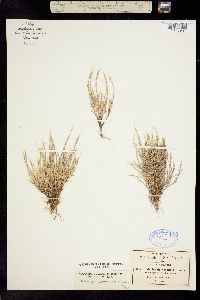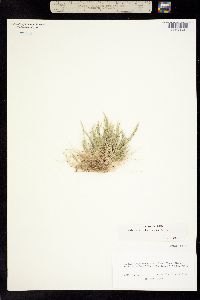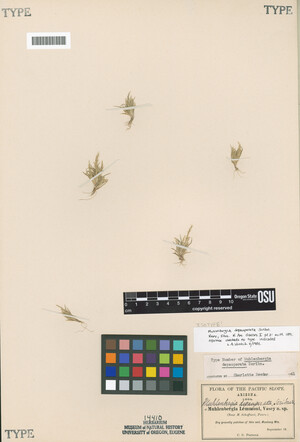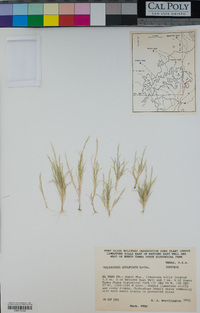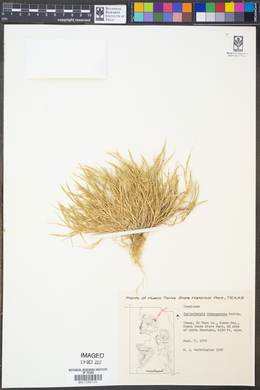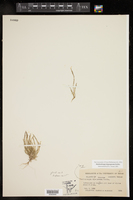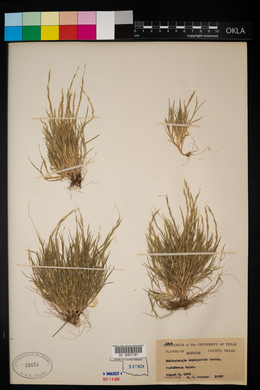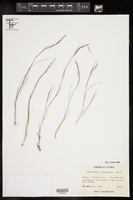Muhlenbergia depauperata
|
|
|
|
Family: Poaceae
Six-Weeks Muhly, more...sixweeks muhly
[Lycurus schaffneri (E. Fourn.) Mez, moreMuhlenbergia schaffneri , Muhlenbergia schaffneri var. schaffneri E. Fourn.] |
Plants annual; tufted. Culms 3-15 cm; internodes mostly scabridulous or pubescent, pubescent or strigose below the nodes. Sheaths often longer than the internodes, somewhat inflated, smooth or scabrous, keeled, margins scarious, not flattened, papery, or spirally coiled when old; ligules1.4-2.5 mm, membranous, acute, with lateral lobes; blades 1-3 cm long, 0.6-1.5 mm wide, flat or involute, scabrous to strigose, midveins and margins thickened, whitish. Panicles 2.5-8.5 cm long, 0.5-0.7 cm wide, contracted; primary branches 1-2.2 cm, appressed, spikelet-bearing to the base, spikelets borne in subsessile-pedicellate pairs; longer pedicels 3-6 mm, scabrous; disarticulation beneath the spikelet pairs. Spikelets 2.5-5.1 mm, appressed. Glumes 2.3-5.1 mm, equaling or exceeding the florets; lower glumes 2.3-4 mm, subulate, 2-veined, minutely to deeply bifid, teeth aristate or with awns to 1.3 mm; upper glumes 3-5.1 mm, lanceolate, 1-veined, entire, acuminate; lemmas 2.5-4.5 mm, narrowly lanceolate, light greenish-brown to purplish, scabrous, appressed-pubescent on the margins and midveins, apices acuminate, awned, awns 6-15 mm, stiff; paleas 2.4-3.6 mm, lanceolate, intercostal region appressed-pubescent, apices acuminate; anthers 0.5-0.8 mm, purplish to yellowish. Caryopses 1.5-2.3 mm, narrowly fusiform, brownish. 2n = 20. Muhlenbergia depauperata grows in gravelly flats, rock outcrops, exposed bedrock, and sandy banks, in grama grassland associations, usually on soils derived from calcareous parent materials, at elevations of 1530-2400 m. Its range extends from the southwestern United States to southern Mexico. Muhlenbergia depauperata and M. brevis share several features with Lycurus: spikelets borne in pairs, 2-veined and 2-awned lower glumes, 1-veined and awned upper glumes, acuminate, awned lemmas with short pubescence along the margins, and pubescent paleas. FNA 2003 Common Name: sixweeks muhly Duration: Annual Nativity: Native Lifeform: Graminoid General: Small tufted annuals with few-many decumbent-erect branches from the base, 3-15 cm tall; internodes mostly pubescent, below the nodes pubescent or strigose. Vegetative: Sheaths somewhat inflated and wrapping around base of inflorescence branches, smooth or scabrous, keeled, margins scarious/transparent, papery, or spirally coiled when old; blades 1-3 cm long, 0.6-1.5 mm wide, flat or involute(margins rolled), scabrous to Inflorescence: Panicles 2.5-8.5 cm long, 0.5-0.7 cm wide, contracted; primary branches 1-2.2 cm, appressed; spikelets borne in subsessile-pedicellate pairs; longer pedicels 3-6 mm, scabrous; disarticulation beneath the spikelet pairs; spikelets 2.5-5.1 mm, appressed; glumes equaling or exceeding the florets, lower glumes 2.3-4 mm, subulate, 2-veined, minutely to deeply bifid, upper glumes 3-5.1 mm, lanceolate, acuminate; lemmas 2.5-4.5 mm, narrowly lanceolate, scabrous, appressed-pubescent on the margins and midveins, apices acuminate with stiff awns 6-15 mm; paleas 2.4-3.6 mm, lanceolate. Ecology: Gravelly flats, rock outcrops, exposed bedrock, and sandy banks, in grassland and scrub associations, usually in calcareous soils (limestone); 5000-8000ft (1530-2400 m). Distribution: c and s UT, n, c and se AZ, NM to c MX. Notes: Distinguished by its small, annual, ascending-decumbent habit, infl. branches which are appressed against the axis forming a contracted, very thin inflorescence that extends past the leaves and sessile-pedicilate spikelet pairs. The leaf sheaths have semi-transparent margins that wrap around the culm and base of some infl. branches. Similar to M. brevis but with shorter lemma awns (6-15mm) as compared to 10-20mm in M. brevis. Can form dense stands in depressions and flats in limestone gravel. Ethnobotany: Unknown Etymology: Muhlenbergia is named for Gotthilf Heinrich Ernst Muhlenberg (1753-1815) a clergyman and botanist from Pennsylvania; depauperata refers to the small, stunted growth form. Synonyms: None Editor: FSCoburn, 2014 |








